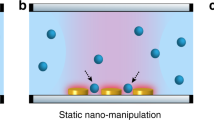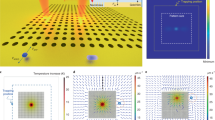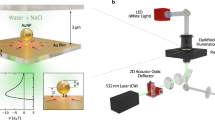Abstract
The ability to manipulate nanoscopic matter precisely is critical for the development of active nanosystems. Optical tweezers1,2,3,4 are excellent tools for transporting particles ranging in size from several micrometres to a few hundred nanometres. Manipulation of dielectric objects with much smaller diameters, however, requires stronger optical confinement and higher intensities than can be provided by these diffraction-limited5 systems. Here we present an approach to optofluidic transport that overcomes these limitations, using sub-wavelength liquid-core slot waveguides6. The technique simultaneously makes use of near-field optical forces to confine matter inside the waveguide and scattering/adsorption forces to transport it. The ability of the slot waveguide to condense the accessible electromagnetic energy to scales as small as 60 nm allows us also to overcome the fundamental diffraction problem. We apply the approach here to the trapping and transport of 75-nm dielectric nanoparticles and λ-DNA molecules. Because trapping occurs along a line, rather than at a point as with traditional point traps7,8, the method provides the ability to handle extended biomolecules directly. We also carry out a detailed numerical analysis that relates the near-field optical forces to release kinetics. We believe that the architecture demonstrated here will help to bridge the gap between optical manipulation and nanofluidics.
This is a preview of subscription content, access via your institution
Access options
Subscribe to this journal
Receive 51 print issues and online access
$199.00 per year
only $3.90 per issue
Buy this article
- Purchase on Springer Link
- Instant access to full article PDF
Prices may be subject to local taxes which are calculated during checkout




Similar content being viewed by others
References
Grier, D. G. A revolution in optical manipulation. Nature 424, 810–816 (2003)
Ashkin, A., Dziedzic, J. M., Bjorkholm, J. E. & Chu, S. Observation of a single-beam gradient force optical trap for dielectric particles. Opt. Lett. 11, 288–290 (1986)
MacDonald, M. P., Spalding, G. C. & Dholakia, K. Microfluidic sorting in an optical lattice. Nature 426, 421–424 (2003)
Grigorenko, A. N., Roberts, N. W., Dickinson, M. R. & Zhang, Y. Nanometric optical tweezers based on nanostructured substrates. Nature Photon. 2, 365–370 (2008)
Born, M. & Wolf, E. Principles of Optics (Pergamon, 2003)
Almeida, V. R., Xu, Q. F., Barrios, C. A. & Lipson, M. Guiding and confining light in void nanostructure. Opt. Lett. 29, 1209–1211 (2004)
Chiu, D. T. & Zare, R. N. Biased diffusion, optical trapping, and manipulation of single molecules in solution. J. Am. Chem. Soc. 118, 6512–6513 (1996)
Hirano, K. et al. Sizing of single globular DNA molecules by using a circular acceleration technique with laser trapping. Anal. Chem. 80, 5197–5202 (2008)
Psaltis, D., Quake, S. R. & Yang, C. H. Developing optofluidic technology through the fusion of microfluidics and optics. Nature 442, 381–386 (2006)
Monat, C., Domachuk, P. & Eggleton, B. J. Integrated optofluidics: A new river of light. Nature Photon. 1, 106–114 (2007)
Neale, S. L., Macdonald, M. P., Dholakia, K. & Krauss, T. F. All-optical control of microfluidic components using form birefringence. Nature Mater. 4, 530–533 (2005)
Chiou, P. Y., Ohta, A. T. & Wu, M. C. Massively parallel manipulation of single cells and microparticles using optical images. Nature 436, 370–372 (2005)
Liu, G. L., Kim, J., Lu, Y. & Lee, L. P. Optofluidic control using photothermal nanoparticles. Nature Mater. 5, 27–32 (2006)
Wang, M. M. et al. Microfluidic sorting of mammalian cells by optical force switching. Nature Biotechnol. 23, 83–87 (2005)
Sinclair, G. et al. Assembly of 3-dimensional structures using programmable holographic optical tweezers. Opt. Express 12, 5475–5480 (2004)
Dholakia, K. & Reece, P. J. in Structured Light and Its Applications (ed. Andrews, D. L.) 107–138 (Academic, 2008)
Righini, M., Zelenina, A. S., Girard, C. & Quidant, R. Parallel and selective trapping in a patterned plasmonic landscape. Nature Phys. 3, 477–480 (2007)
Marchington, R. F. et al. Optical deflection and sorting of microparticles in a near-field optical geometry. Opt. Express 16, 3712–3726 (2008)
Cizmar, T. et al. Optical sorting and detection of submicrometer objects in a motional standing wave. Phys. Rev. B 74, 035105 (2006)
Schmidt, B. S., Yang, A. H., Erickson, D. & Lipson, M. Optofluidic trapping and transport on solid core waveguides within a microfluidic device. Opt. Express 15, 14322–14334 (2007)
Ng, L. N., Luf, B. J., Zervas, M. N. & Wilkinson, J. S. Forces on a Rayleigh particle in the cover region of a planar waveguide. J. Lightwave Technol. 18, 388–400 (2000)
Grujic, K., Helleso, O. G., Hole, J. P. & Wilkinson, J. S. Sorting of polystyrene microspheres using a Y-branched optical waveguide. Opt. Express 13, 1–7 (2005)
Gaugiran, S., Gétin, S., Fedeli, J. M. & Derouard, J. Polarization and particle size dependence of radiative forces on small metallic particles in evanescent optical fields. Evidences for either repulsive or attractive gradient forces. Opt. Express 15, 8146–8156 (2007)
Ng, L. N., Luff, B. J., Zervas, M. N. & Wilkinson, J. S. Propulsion of gold nanoparticles on optical waveguides. Opt. Commun. 208, 117–124 (2002)
Gaugiran, S. et al. Optical manipulation of microparticles and cells on silicon nitride waveguides. Opt. Express 13, 6956–6963 (2005)
Yang, A. H. J. & Erickson, D. Stability analysis of optofluidic transport on solid-core waveguiding structures. Nanotechnology 19, 045704 (2008)
Hart, S. J., Terray, A., Leski, T. A., Arnold, J. & Stroud, R. Discovery of a significant optical chromatographic difference between spores of Bacillus anthracis and its close relative, Bacillus thuringiensis . Anal. Chem. 78, 3221–3225 (2006)
Svoboda, K. & Block, S. M. Optical trapping of metallic Rayleigh particles. Opt. Lett. 19, 930–932 (1994)
Braslavsky, I., Hebert, B., Kartalov, E. & Quake, S. R. Sequence information can be obtained from single DNA molecules. Proc. Natl Acad. Sci. USA 100, 3960–3964 (2003)
Woolley, A. T., Guillemette, C., Cheung, C. L., Housman, D. E. & Lieber, C. M. Direct haplotyping of kilobase-size DNA using carbon nanotube probes. Nature Biotechnol. 18, 760–763 (2000)
Acknowledgements
We thank A. Stroock for discussions, and A. Nitkowski and S. Manipatruni for technical support. This work was done in part at the Cornell NanoScale Facility, a member of the National Nanotechnology Infrastructure Network, which is supported by the US National Science Foundation. This work was funded by the US National Science Foundation NIRT: Active Nanophotofluidic Systems for Single Molecule/Particle Analysis (award number 0708599).
Author Contributions A.H.J.Y. and S.D.M. were responsible for running the bulk of the trapping experiments and analysing data. A.H.J.Y. carried out the simulation calculations. B.S.S was responsible for running initial experiments and fabrication of the slot waveguide chips. M.K. developed the DNA imaging methods. A.H.J.Y., M.L. and D.E. were responsible for writing the paper. All authors discussed the results and commented on the manuscript.
Author information
Authors and Affiliations
Corresponding author
Supplementary information
Supplementary Information
This file contains Supplementary Data and Supplementary References (PDF 78 kb)
Supplementary Movie 1
Stable nanoparticle trapping and controlled release by the slot waveguide. This movie demonstrates the high stability, long term trapping of many 75nm polystyrene particles by and optically excited 100nm slot waveguide. In this case, the slot waveguide is excited and particles flowing over it are allowed to accumulate for some time. In the first half of the movie the particles are released by removing the excitation power and in the second half they are released by switching polarity. This capture and release is also shown in Figure 2. (MOV 2065 kb)
Supplementary Movie 2
Nanoparticle capture by the slot waveguide. This movie demonstrates the capture and trapping of two individual 100nm polystyrene particles by an optically excited 120nm slot waveguide. In this movie, the particles are initially flowing from left to right by a microfluidic flow. They are trapped near the stability point and the particle is released when the random thermal energy exceeds the work required to break the trap. (MOV 2740 kb)
Supplementary Movie 3
Optical force transport of a single nanoparticle inside the slot waveguide. In this movie, we demonstrate the optical force transport of a single 100nm particle inside a 120nm slot waveguide. This transport is also shown in Figure 2. (MOV 3979 kb)
Supplementary Movie 4
Biomolecular trapping inside the slot waveguide. In this movie, we demonstrate optical trapping of Yo-Yo tagged lambda-DNA by the slot waveguide. The DNA is initially flowing from left to right in the microchannel and becomes trapped on a 60nm slot waveguide. The DNA is released at the end of the movie when the optical power is removed. Note that when no optical power is applied, no DNA is trapped indicating that the effect is entirely optical, not hydrodynamic. This trapping is also shown in Figure 3. (MOV 10734 kb)
Rights and permissions
About this article
Cite this article
Yang, A., Moore, S., Schmidt, B. et al. Optical manipulation of nanoparticles and biomolecules in sub-wavelength slot waveguides. Nature 457, 71–75 (2009). https://doi.org/10.1038/nature07593
Received:
Accepted:
Issue Date:
DOI: https://doi.org/10.1038/nature07593
This article is cited by
-
Acoustically manipulating internal structure of disk-in-sphere endoskeletal droplets
Nature Communications (2022)
-
Resonator nanophotonic standing-wave array trap for single-molecule manipulation and measurement
Nature Communications (2022)
-
Passively and actively enhanced surface plasmon resonance sensing strategies towards single molecular detection
Nano Research (2022)
-
Magneto-optical binding in the near field
Scientific Reports (2021)
-
Acoustoelectronic nanotweezers enable dynamic and large-scale control of nanomaterials
Nature Communications (2021)
Comments
By submitting a comment you agree to abide by our Terms and Community Guidelines. If you find something abusive or that does not comply with our terms or guidelines please flag it as inappropriate.



